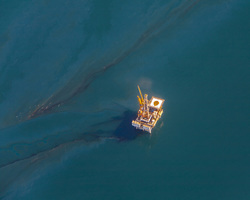
While screening gets large trash out of the effluent, petrochemicals including motor oil, diesel, gasoline, and lubricants seem to be the most common and problematic offending pollutants. If the hydrocarbon is in a thick layer, it is often skimmed off using vacuum trucks and oil adsorbents (it is then taken for reprocessing as slop oil). In most cases, operators are faced with a slight petroleum sheen that is difficult to remove by physical methods.
The easiest way to deal with light hydrocarbon sheen and water soluble hydrocarbons is to use biological treatment. By adding mixing via an aerator or mixer, the hydrocarbons (food source) are mixed with microbes that are present in the water column.
In cases where the hydrocarbon loading has increased rapidly and the number of microbes utilizing hydrocarbons as food is low, treatment rates can be increased by adding a concentrate of hydrocarbon degrading microbes. This helps remove the problem compounds within 5 - 28 Days (temperature, mixing, and hydrocarbon concentration make up for the variation in time). With treatment completed, the water can be safely discharged to receiving streams.

 RSS Feed
RSS Feed